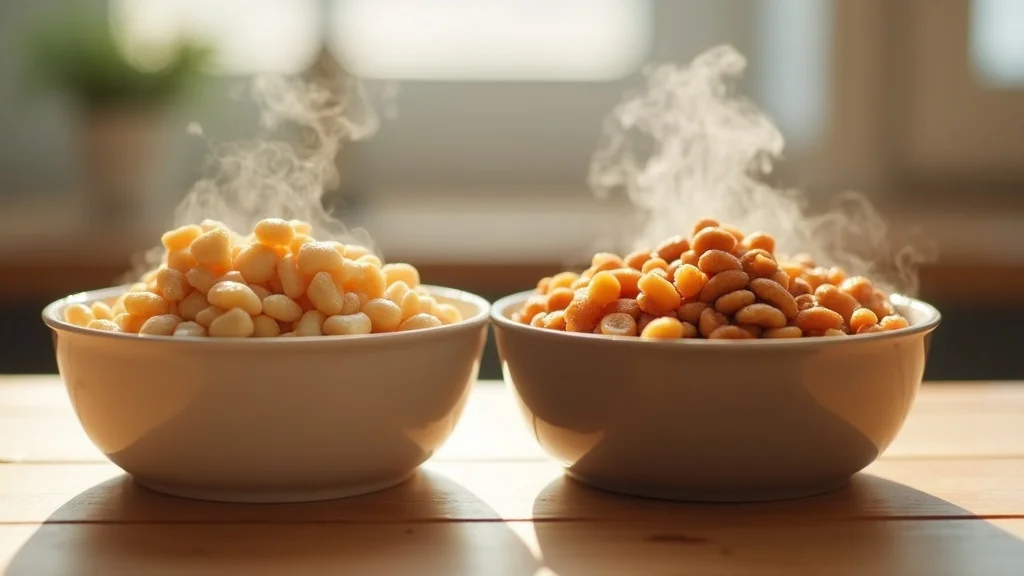Are you sure your puppy is getting the right start in life, or could the food in their bowl steer their health for years to come? Discover the secrets to raising a healthy, energetic, and happy puppy by feeding them the ideal diet tailored for their unique needs.
Unlocking Puppy Potential: What is the Ideal Diet for a Puppy?
“Proper nutrition during the puppy stage lays the foundation for a healthy adult dog.” – Veterinary Nutritionist

Setting your growing pup up for a lifetime of health and energy starts with understanding what is the ideal diet for a puppy. Puppyhood is a crucial stage where nutrition impacts physical growth, muscle development, brain function, and immune strength. Whether you have a tiny teacup or a future giant, the food choices you make today shape their lifelong wellness. Proper puppy food goes far beyond filling a bowl—it's about delivering essential nutrients in the right balance, at the right time, in the optimal form for your dog’s breed and size. From protein-packed meals to healthy fat sources, choosing the ideal diet can seem overwhelming with so many dog food options out there. This comprehensive guide helps you navigate breed factors, commercial vs homemade diets, feeding schedules, and common pitfalls so you can confidently feed your pup for vibrant health.
The Growing Pup: Why Nutrition Matters Early
The first year of a puppy’s life is a period of rapid change—bones lengthen, muscles strengthen, and organs mature. Unlike adult dogs, growing puppies require higher levels of protein, essential amino acids, and balanced minerals to build healthy bodies. Inadequate nutrition during this window can lead to weak bones, stunted growth, or even lifelong joint problems, especially in large and giant breed puppies. Early nutrition also shapes a puppy’s cognitive abilities and immune system, setting the groundwork for how easily they learn new commands and fight off illness. Choosing the right puppy food, with support from your veterinarian, is vital for unlocking your pup’s full genetic potential and building a resilient, happy companion.
What You’ll Learn About the Ideal Diet for a Puppy
Fundamentals of what is the ideal diet for a puppy
Differences in diet for giant breed, small breed, and medium breed puppies
Essential nutrients every growing pup needs
Best practices for feeding your pup
Key differences between puppy food and adult dog food
Top FAQs answered with evidence-based insight
Puppy Nutrition Basics: Understanding What is the Ideal Diet for a Puppy
When it comes to what is the ideal diet for a puppy, focusing on key nutrients is the best place to start. Puppy food should offer a careful balance of protein, fat, vitamins, minerals, and energy to support their rapid growth. Unlike food for adult dogs, formulas for growing puppies have more protein and fats for muscle and tissue development, along with controlled calcium and phosphorus for strong bones. Puppies also need more DHA (an omega-3 fatty acid) for brain development. Both commercial puppy food and home-prepared meals must be complete and balanced, and portion sizes should be appropriate for your puppy's age, breed, and activity level. Feeding your pup correctly from the start lays the groundwork for confident, healthy adulthood.

Essential Nutrients Required by Growing Puppies
A balanced puppy diet should be rich in high-quality protein, which provides the amino acids needed to build muscles and tissue as puppies grow quickly. Fats supply key energy and enable the absorption of fat-soluble vitamins. Your growing pup also needs a healthy concentration of DHA for learning, calcium and phosphorus in the right proportion for bone strength, and trace minerals to support everything from nerve transmission to immune response. Carbohydrates, while not essential, are included in most dog food for their energy contribution and as carriers for essential nutrients. Look for foods, whether commercial puppy food or homemade, that meet the AAFCO standards for growing puppies. Always ensure that protein sources are easily digestible and that meals aren’t fortified with excessive vitamins or minerals, which can stress organs or disrupt healthy growth.
The Role of Protein and Fats in Puppy Food
Protein is the cornerstone of any high-quality puppy food. Puppies require more protein than adult dogs because their bodies are constantly building new tissues. Look for animal-sourced proteins such as chicken, beef, fish, or lamb, which offer the full spectrum of essential amino acids. Fats, in the form of both omega-3 and omega-6 fatty acids, are equally vital—they provide concentrated energy necessary for playful, active puppies and promote proper brain and retinal development. The best puppy foods carefully balance these macronutrients to support healthy skin, a shiny coat, strong muscles, and resilient organs. Avoid foods with too much fat or low-quality meat byproducts, and remember that puppies need more calories per pound than adult dogs to fuel their growth and curiosity.
Macronutrient Breakdown: Protein, Fat, Carbohydrates for Puppies vs Adult Dogs |
||
Nutrient |
Puppies (Recommended %) |
Adult Dogs (Recommended %) |
|---|---|---|
Protein |
22–32% |
18–24% |
Fat |
8–20% |
5–15% |
Carbohydrates |
Fillers/Balanced |
Fillers/Balanced |
Breed-Specific Considerations: What is the Ideal Diet for a Puppy of Every Size?

Not all puppies are created equal—especially when it comes to dietary needs. The ideal puppy diet varies significantly for small breed, medium breed, and giant breed puppies. Size, genetics, and growth rates all factor into how you feed your pup to ensure optimum development. For example, giant breed puppies grow quickly but are more susceptible to joint and bone disorders if their food is not carefully balanced. Small and medium breed puppies have higher metabolisms and require more concentrated energy per pound. Whether you are feeding tiny teacups or future gentle giants, understanding breed differences is essential for raising healthy puppies and preventing lifelong problems associated with improper nutrition.
Giant Breed Puppy Diet: Special Needs and Precautions
Giant breed puppies require extra attention to calcium, phosphorus, and protein levels to avoid overly rapid growth that can stress joints and bones. Unlike other puppies, these large and giant breeds (like Great Danes and Mastiffs) should not receive excessive calcium, which can lead to skeletal abnormalities. Their optimal puppy food is specifically labeled for large and giant breed puppies, offering a precise balance to slow their growth just enough for healthy skeletal development. Calories are still plentiful, but the diet avoids extra calories that encourage unsafe weight gain or fast growth. Regularly monitor your puppy's weight with your vet, since even a small amount of overfeeding may contribute to hip dysplasia or arthritis later in life.
"Dietary missteps in giant breed puppies can have lifelong consequences." – Board Certified Veterinary Nutritionist
Small Breed and Medium Breed Puppies: Dietary Differences
Small and medium breed puppies generally have higher metabolic rates and thus need more calories per pound of body weight than their larger cousins. Their ideal puppy food is formulated with higher fat and protein to accommodate their energy needs, plus smaller kibble size for easy eating. Watch portion sizes closely, as small breed puppies are more prone to hypoglycemia if not fed frequently. Medium breed puppies—like Beagles or Border Collies—fit somewhere in between, and adjustments depend on growth rate and activity level. Always use a feeding schedule and monitor weight regularly to ensure your healthy pup grows at an optimal rate without becoming overweight.
When Should You Switch to Adult Dog Food?
The transition from puppy food to adult dog food is a critical milestone. Puppies should stay on a complete growth formula until they reach about 80–90% of their expected adult body weight. For small and medium breed dogs, this is often between 10-12 months, while large and giant breed dogs may need puppy food for up to 18–24 months. Abruptly switching too soon can deprive your growing puppy of essential nutrients needed to finish development. Always transition gradually over a 7-10 day period by mixing increasing amounts of adult food with puppy food, and consult with your veterinarian before making the final shift to ensure your growing pup’s needs are met.
Selecting Puppy Food: Commercial Puppy Food vs Homemade Diets
With so many dog food choices lining the shelves and the growing trend of homemade and raw diets, it’s natural to wonder which is best for your puppy. Commercial puppy food is carefully formulated to meet AAFCO standards and should be labeled as “complete and balanced” for the growth life stage. Homemade diets, while tempting, can easily fall short or become imbalanced without expert guidance. Both approaches require diligence—reading labels, monitoring for recalls, and seeking professional advice. Whether you choose commercial puppy food or a home-prepared diet, the priority is ensuring your pup receives all essential nutrients in the right proportions.
How to Choose High-Quality Commercial Puppy Food
Not all commercial puppy foods are created equal. Look for products displaying the AAFCO (Association of American Feed Control Officials) statement indicating suitability for “growth” or “all life stages.” Examine the ingredient list: quality animal protein should be first, supported by digestible grains or vegetables, with minimal fillers and byproducts. Check for key nutrients like DHA, calcium, phosphorus, and antioxidants such as vitamin E. Avoid foods with artificial colors, flavors, or excessive preservatives. Your vet can also recommend trusted brands based on your breed puppy’s unique needs. Remember to pick suitable formulas for small breeds or large and giant breeds, as nutritional profiles differ.
Comparison: Commercial Puppy Food vs Homemade Diets |
||
Aspect |
Commercial Puppy Food |
Homemade Diets |
|---|---|---|
Nutritional Balance |
Precise, formulated to AAFCO standards |
Varies, risk of imbalances unless vet-formulated |
Convenience |
Very high; easy storage and feeding |
Time-consuming to prepare and plan |
Ingredient Control |
Set by manufacturer; less control |
Full control over all ingredients |
Cost |
Varies—economical to premium |
Often higher due to fresh ingredients |
Safety |
Monitored for recalls, generally consistent |
Food safety depends on home food handling |
Understanding Puppy Food Labels: What to Look For

Puppy food labels can be complex, filled with marketing buzzwords and ingredient jargon. Start by checking for an AAFCO statement of nutritional adequacy for growth. High-quality commercial puppy food will list a clear animal protein source as the first ingredient, followed by wholesome grains or vegetables. Examine guaranteed analysis for key metrics: protein (at least 22%), fat, calcium, and DHA. Avoid foods with vague “meat meals,” byproducts as the main source, and unnecessary additives. If your puppy has special needs, look for “limited ingredient” or “grain-free” formulas, but only with veterinary guidance. Always select a formula matched to your puppy’s expected adult size for best results.
Is Raw Food or Home-Prepared Diet Safe for Your Growing Pup?
Raw and homemade diets offer ingredient control but require careful planning. Raw diets may increase pathogen risk if not handled properly, while home-prepared diets demand precision to avoid dangerous imbalances in protein, calcium, and vitamins. If you wish to prepare meals at home, consult a board certified veterinary nutritionist to formulate a recipe and supplement plan that ensures your growing pup receives every essential nutrient. Never assume a home recipe online is appropriate for your puppy’s needs, as the consequences of nutritional gaps during growth can be serious and sometimes irreversible.
How to Feed Your Puppy: Schedules, Portions, and Feeding Guidelines
Routine is vital when feeding your growing pup. A proper feeding schedule, matched with the right amount of food and regular health monitoring, prevents underfeeding or obesity. Young puppies typically need to eat three to four times daily, while older puppies may transition to two meals per day as they approach adulthood. Serve food in a quiet, clean spot and allocate enough time for your pup to eat without distractions. Always adjust portion size based on breed, age, activity level, and the body condition of your puppy. Keep an eye on signs of healthy growth and don’t hesitate to ask your vet if you’re unsure about increasing or decreasing food intake.
How Many Meals Should You Feed Your Pup Daily?

Most veterinarians recommend that growing puppies eat at least three times per day until around six months old to maintain steady energy levels and prevent low blood sugar, especially in tiny breeds. After six months, many puppies can transition to twice daily feeding, much like adult dogs. Meals distributed throughout the day support digestion and provide bursts of energy needed for active play and learning. Skipping meals can lead to hypoglycemia, while overfeeding at one meal increases the risk of obesity and digestive upset. Sticking to a regular feeding schedule and keeping treats to a small amount ensures your pup’s nutritional requirements are met without excess. Every puppy is unique, so consult your vet to determine the right frequency and adjust as your puppy grows.
Feed Your Puppy: Portion Control Based on Weight and Age
Portion control is a cornerstone of a balanced puppy diet and prevents both malnourishment and unhealthy weight gain. Check the feeding guidelines on your chosen puppy food bag, which usually offer recommended daily amounts based on weight and anticipated adult size. Puppies with a higher activity level or those that grow quickly may require slightly larger portions, while less active pups need less food. Weigh your puppy regularly and evaluate their body condition—an ideal growing pup will have visible waistline and ribs that are easily felt but not seen. If you’re unsure how much to feed your puppy at each stage, use a puppy feeding schedule and consult your vet as your dog matures.
Puppy Feeding Schedule by Age and Size |
|||
Puppy Age |
Small/Medium Breeds |
Large/Giant Breeds |
Meals per Day |
|---|---|---|---|
2–4 months |
1/2–1 cup |
1–2 cups |
4 |
4–6 months |
1–1.5 cups |
2–3 cups |
3 |
6–12 months |
1–2 cups |
2.5–4 cups |
2 |
Signs of Healthy Growth in Growing Puppies
A healthy pup should have steady, predictable growth, a glossy coat, bright eyes, and a lively playful attitude. Monitor for signs of underfeeding, such as prominent ribs, a dull coat, or lack of energy. Conversely, excessive weight gain, sluggishness, or difficulty moving can signal overfeeding. Puppies should gain weight gradually, with each breed following its own expected growth curve. Periodic body condition scoring or a simple “feel test” of the ribs and waist can offer guidance. Routine check-ups with your vet allow for early intervention if anything seems off with your puppy’s diet or growth rate.
"Regular monitoring and appropriate feeding keep growing puppies on the right track."
Dry Food, Wet Food, or Mixed Diets: What is the Ideal Diet for a Puppy?
Choosing between dry food, wet food, or a mix for your puppy often comes down to convenience, nutritional value, and your puppy’s preferences. High-quality dry food offers dental benefits and is easy to manage. Wet food provides extra water content and is often more palatable, particularly for picky or small breed puppies. Some pet parents opt for mixed diets—combining both wet and dry food—to deliver variety and keep mealtime exciting. No matter which route you choose, ensure that the food is formulated specifically for puppies and meets all nutritional guidelines for healthy growth.

Pros and Cons of Dry Food for Growing Puppies
Dry food, or kibble, is one of the most popular choices for puppy owners due to its convenience, affordability, and longer shelf life. Quality dry puppy foods are designed to be nutritionally complete and are especially helpful in supporting dental health, as the crunching action helps reduce tartar buildup. However, very young or teething puppies, as well as those with dental issues, may struggle with hard kibble, so consider soaking it in warm water to soften if needed. Not all dry foods are created equal—choose ones with high animal protein content and minimal fillers. Check the calorie count to avoid overfeeding, and always ensure fresh water is available with dry food.
Benefits and Drawbacks of Wet Food for Puppies
Wet food is highly palatable and often favored by picky eaters or puppies with dental concerns. The higher moisture content helps contribute to overall hydration, which can benefit puppies that are not frequent drinkers. Wet puppy foods can be easier to digest, but they are generally more expensive, require refrigeration once opened, and can promote plaque buildup without additional dental care. They are also less calorie-dense than dry food, so portion sizes may look larger but contain fewer nutrients per bite. For best results, select a wet food labeled for puppies and use it as a main diet or as a topper for dry food.
Mixing Diets for Your Puppy: What Works Best?
Many pet owners find that a mixed diet—offering both dry and wet puppy food—strikes the perfect balance between convenience and taste. Mixing diets can encourage picky eaters and improve hydration while maintaining dental benefits from the dry portion. If you choose to combine wet and dry food, be careful to account for the total daily caloric intake to avoid overfeeding your growing pup. Introduce new combinations gradually and monitor for digestive upsets. Always select both wet and dry foods that are complete and balanced for growth, and consult your veterinarian if your puppy has any food sensitivities or allergies.
Common Mistakes in Puppy Diets and How to Avoid Them
Feeding adult food too early: Puppies require growth formulas until maturity to avoid nutritional deficiencies.
Overlooking specific breed requirements: Giant breeds, especially, need careful calcium and calorie control.
Ignoring portion guidelines: Overfeeding leads to obesity, while underfeeding stunts healthy growth.
Supplementing incorrectly: Too many vitamins or minerals can throw off nutritional balance and harm your puppy.
How to Correctly Transition Your Puppy’s Diet

When it’s time to transition your puppy’s diet—such as moving from puppy to adult food—do it slowly over at least 7-10 days. Start by mixing a small amount of the new food with the old, increasing the new and decreasing the old daily. This gradual approach reduces the risk of digestive upset, diarrhea, or food refusal. Watch your puppy’s stool, energy levels, and appetite for any changes, and hold off making further adjustments if you see signs of gastrointestinal distress. Each puppy is unique—what works well for one growing pup may need modification for another, so personalize your puppy’s feeding plan and check in with your vet for reassurance.
People Also Ask: Puppy Nutrition
What is a proper diet for a puppy?
A proper diet for a puppy is a complete and balanced meal formulated specifically for growth, rich in protein, essential fats, DHA for brain development, balanced minerals, and appropriate calories. It should be adjusted according to breed size and age.
What is the 5 minute rule for puppies?
The 5 minute rule suggests five minutes of exercise per month of age, twice a day, to avoid overexertion and joint issues in growing puppies.
What is the best food for puppies to eat?
The best food for puppies is a high-quality commercial puppy food carrying an AAFCO label, tailored to the puppy’s size and breed for complete nutrition.
Is 1 cup of food a day enough for a puppy?
One cup of food may not be sufficient or may be excessive, depending on the puppy’s breed size, age, and caloric requirement. Always refer to food package guidelines and consult your vet for personalized advice.
FAQs: What is the Ideal Diet for a Puppy
Can I feed my puppy homemade food every day?
While it’s possible to feed your puppy homemade food daily, doing so requires careful formulation to avoid dangerous nutritional gaps or excesses. Recipes should come from a board certified veterinary nutritionist—not from random websites or social media. Most owners find that commercial puppy food is a safer, more reliable option unless guided by a professional.
Are supplements needed in a puppy’s diet?

Most healthy, well-fed puppies on balanced commercial puppy food do not need supplements. Too much calcium, phosphorus, or vitamins can harm your puppy instead of helping. Supplements are only recommended under veterinary guidance for specific health challenges. If you’re feeding a homemade diet, supplements are likely necessary, but only as part of a vet-formulated plan.
When do I switch my puppy to adult food?
Switch your puppy to adult food when they reach about 80–90% of their expected adult weight—usually 10–12 months for small and medium breeds and up to 24 months for giant breeds. Make the transition gradually over a week or more.
What treats are safe for puppies?
Safe puppy treats include tiny portions of their regular puppy food, soft commercial puppy treats, or bite-sized pieces of cooked chicken or carrots. Avoid human snacks, bones, rawhide, or any treats labeled for adult dogs due to choking hazards or unsuitable ingredients.
Key Takeaways: What is the Ideal Diet for a Puppy
What is the ideal diet for a puppy varies by breed and size
Commercial puppy food usually provides balanced nutrition
Monitor growth and adapt diet as needed
Consult a veterinarian when in doubt
Expert veterinarian explains the ideal diet for puppies using props, feeding samples, and breed examples—set in a bright, modern animal clinic with explanatory charts and food close-ups.
Conclusion: Setting Your Growing Pup on the Path to Healthy Adulthood
Start your puppy off right—with the ideal diet, careful monitoring, and expert guidance—to ensure a lifetime of health, happiness, and wagging tails!
Stay informed. Stay inspired. Subscribe to our monthly pet newsletter for the best in cat and dog care. 🐾 Join now — your inbox will thank you. https://pawpressnews.com/
Ensuring your puppy receives optimal nutrition is crucial for their growth and development. To deepen your understanding, consider exploring the following resources:
“Your Puppy’s Diet & Nutritional Needs”: This article outlines the essential nutrients puppies require, such as protein, fat, calcium, and DHA, and explains their roles in supporting healthy growth. (purina.com)
“Proper Puppy Nutrition Nourishes Rapid Growth”: This resource emphasizes the importance of providing complete and balanced nutrition during the early stages of a puppy’s life to ensure proper development. (akc.org)
By consulting these resources, you can gain comprehensive insights into formulating a diet that supports your puppy’s health and vitality.
 Add Row
Add Row  Add
Add 




Write A Comment